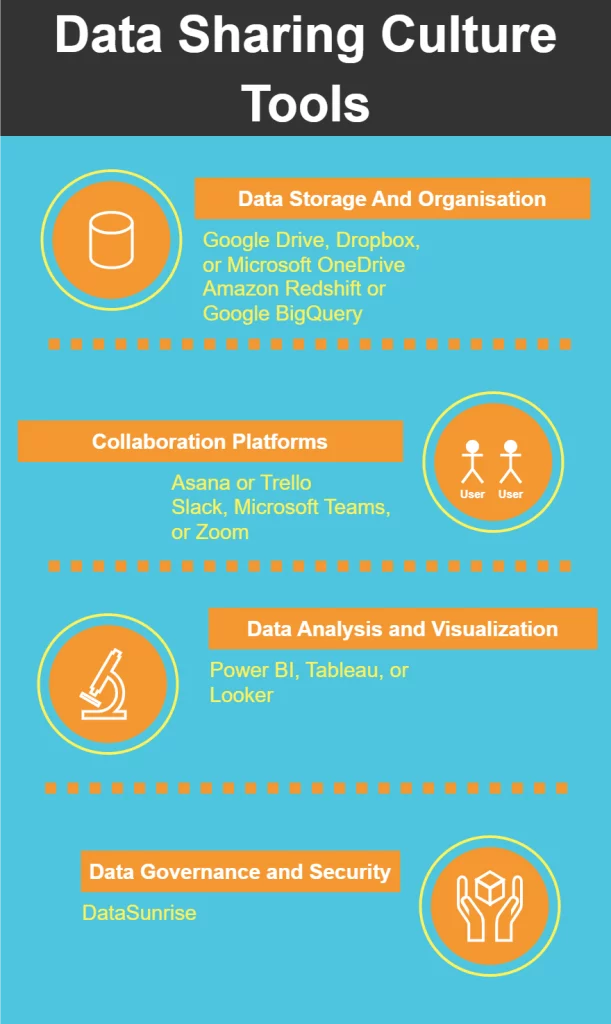
Data Sharing Culture
Introduction: The Power of Shared Knowledge
Did you know that Netflix in ’97 was started as a DVD rental company? It transitioned from a DVD rental service to a streaming giant by leveraging viewer data to create popular original content and personalize recommendations. Another example – Uber disrupted the taxi industry by using real-time data to match riders with drivers efficiently. In today’s interconnected world, data has become the lifeblood of businesses. The ability to share and leverage data effectively can make the difference between success and failure. But what exactly is data sharing, and why is it so crucial for modern organizations?
Data sharing is the practice of making data available to multiple stakeholders, both within and outside an organization. It’s not just about transferring files; it’s about creating a culture where information flows freely, securely, and productively. This article will explore the fundamentals of data sharing culture, the tools that make it possible, and the principles that ensure it’s done safely and effectively.
What is Data Sharing?
At its core, data sharing is the act of making data accessible to multiple parties. But in a business context, it goes beyond simply granting access. A robust data sharing culture involves:
- Collaboration: Teams working together, using shared data to solve problems and innovate.
- Transparency: Clear guidelines on what data can be shared, with whom, and for what purposes.
- Security: Protecting sensitive information while still allowing necessary access.
- Efficiency: Streamlining processes to avoid data silos and redundant work.
The Benefits of a Strong Data Sharing Culture
Organizations that embrace data sharing often see significant benefits:
- Improved decision-making through access to more comprehensive information
- Increased innovation as diverse teams combine insights
- Enhanced efficiency by reducing duplicate efforts
- Better customer experiences through more holistic understanding of needs
For example, a retail company that shares sales data across departments might enable its marketing team to create more targeted campaigns, while the supply chain team can optimize inventory levels. This collaboration leads to increased sales and reduced costs.
Tools for Data Management and Sharing

To build a strong data sharing culture, you need the right tools. Here are some essential categories:
1. Data Storage and Organization
- Cloud Storage Solutions: Services like Google Drive, Dropbox, or Microsoft OneDrive allow easy file sharing and collaboration.
- Data Warehouses: Tools like Amazon Redshift or Google BigQuery store and organize large volumes of structured data.
2. Collaboration Platforms
- Project Management Tools: Platforms like Asana or Trello help teams organize and share project-related data.
- Communication Tools: Slack, Microsoft Teams, or Zoom facilitate real-time data sharing and discussion.
3. Data Analysis and Visualization
- Business Intelligence Tools: Power BI, Tableau, or Looker help teams analyze and visualize shared data.
- Jupyter Notebooks: Allow data scientists to share code, visualizations, and analysis in a single document.
4. Data Governance and Shared Data Security
- Access Control Systems: Tools that manage who can access what data and when.
- Data Masking Tools: Software that obscures sensitive data while preserving its utility for analysis.
Principles of Data Sharing Culture for Secure Data Processing
Creating a data sharing culture isn’t just about implementing tools. It requires a shift in mindset and the adoption of key principles:
1. Open by Default, Secure by Design
Encourage a mindset where sharing is the norm, not the exception. However, this openness should be built on a foundation of robust security.
Example: A software development company might use a version control system like Git, where code is shared by default among team members. Access controls ensure that only authorized personnel can make changes to production code.
2. Clear Data Classification
Not all data is created equal. Establish a clear system for classifying data based on sensitivity and importance.
Example: A healthcare provider might classify patient data as “Highly Confidential,” financial data as “Confidential,” and public health statistics as “Public.”
3. Role-Based Access Control
Implement a system where data access is based on an individual’s role within the organization.
Example: In a financial institution, analysts might have read-only access to transaction data, while compliance officers have full access for auditing purposes.
4. Data Quality Assurance
Shared data is only valuable if it’s accurate and reliable. Implement processes to ensure data quality.
Example: A manufacturing company might use automated data validation tools to check for errors in production data before it’s shared across departments.
5. Continuous Education and Training
Regularly train employees on data sharing best practices and the importance of data security.
Example: A tech company might conduct quarterly workshops on new data sharing tools and updated security protocols.
6. Transparency in Data Usage
Make it clear how shared data is being used and for what purposes.
Example: A marketing team sharing customer data with the product development team should clearly document how this data will inform new feature development.
7. Ethical Considerations
Establish guidelines for the ethical use of shared data, especially when it comes to personal information.
Example: A social media company might have strict policies about how user data can be used for targeted advertising, ensuring compliance with privacy regulations.
Implementing a Data Sharing Culture: Best Practices
Now that we’ve covered the principles, let’s look at some practical steps for implementing a data sharing culture:
1. Start with a Data Inventory
Before you can effectively share data, you need to know what data you have. Conduct a comprehensive inventory of your organization’s data assets.
Here we just provide the simplest example of csv-based inventory for PostgreSQL in Python:
import psycopg2
import csv
conn = psycopg2.connect("dbname=your_db user=your_user password=your_password")
cur = conn.cursor()
# Query to get all tables
cur.execute("""
SELECT table_schema, table_name
FROM information_schema.tables
WHERE table_type = 'BASE TABLE'
""")
# Write results to a CSV file
with open('postgres_inventory.csv', 'w', newline='') as f:
writer = csv.writer(f)
writer.writerow(['Schema', 'Table'])
writer.writerows(cur.fetchall())
cur.close()
conn.close()2. Develop a Data Governance Framework
Create clear policies and procedures for data sharing, including:
- Who can access what data
- How data should be classified
- Processes for requesting and granting access
- Guidelines for data usage and sharing with external parties
3. Invest in the Right Tools
Based on your organization’s needs, invest in tools that facilitate secure data sharing. This might include:
- A centralized data platform
- Collaboration tools with robust security features
- Data masking and encryption tools
4. Foster a Culture of Trust
Encourage open communication about data sharing. Address concerns proactively and demonstrate the benefits of sharing through concrete examples and success stories.
5. Implement Monitoring and Auditing
Regularly monitor data access and usage. Conduct audits to ensure compliance with your data sharing policies.
6. Continuously Improve
Regularly review and update your data sharing practices. Seek feedback from employees and stakeholders to identify areas for improvement.
Overcoming Challenges in Data Sharing
While the benefits of a data sharing culture are clear, implementing one isn’t without challenges. Here are some common obstacles and strategies to overcome them:
1. Data Silos
Challenge: Different departments or teams hoard data, reluctant to share.
Solution: Demonstrate the value of sharing through pilot projects. Show how shared data leads to better outcomes for everyone.
2. Security Concerns
Challenge: Fear of data breaches or misuse can hinder sharing.
Solution: Implement robust security measures and clearly communicate them. Show how controlled sharing can actually enhance security by reducing shadow IT.
3. Data Quality Issues
Challenge: Inconsistent or inaccurate data across different sources.
Solution: Implement data quality management processes. Use tools to standardize and clean data before sharing.
4. Regulatory Compliance
Challenge: Ensuring data sharing complies with regulations like GDPR or HIPAA.
Solution: Work closely with legal and compliance teams. Implement tools that help automate compliance, such as data masking for sensitive information.
The Future of Data Sharing
As technology evolves, so too will data sharing practices. Some trends to watch:
- AI-Driven Data Sharing: Machine learning algorithms helping to automate data classification and access decisions.
- Blockchain for Data Integrity: Using blockchain technology to ensure the provenance and integrity of shared data.
- Federated Learning: Allowing organizations to collaboratively train AI models without directly sharing sensitive data.
Conclusion: Embracing the Data Sharing Revolution
In today’s data-driven world, organizations that master the art of secure and effective data sharing will have a significant competitive advantage. By fostering a culture of data sharing, implementing the right tools and principles, and addressing challenges head-on, businesses can unlock the full potential of their data assets.
Remember, building a data sharing culture is an ongoing process. It requires commitment, clear communication, and a willingness to adapt. But the rewards – improved decision-making, increased innovation, and enhanced collaboration – make it well worth the effort.
As you embark on your data sharing journey, consider tools that can help you maintain security and compliance. DataSunrise offers user-friendly and flexible solutions for database security and compliance, ensuring that your data sharing initiatives remain safe and effective. Visit our website for an online demo and discover how we can support your organization’s data sharing culture.
